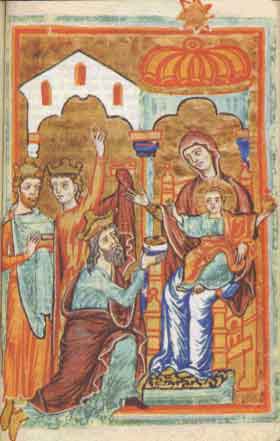Christmastide X |
|||
Whom have ye seen, O shepherds? Speak, tell us who hast appeared on the earth. We have seen a new-born child, and choirs of angels praising the Lord, alleluia, alleluia. -- Antiphon 1, Christmas Lauds |
|||
|
The Feast of the Nativity commemorates the beginning of the end to darkness, that moment in time when the Savior first appeared on earth to redeem us from our sins. But like the shepherds mentioned in the antiphon above, we must know who this Savior is in order to be transformed by worship of Him. The Christmas season, or Christmastide, helps us towards this end. By openly contemplating the Light that was hinted at throughout the season of Advent, Christmastide recapitulates our Lord's gradual self-revelation to the world. Indeed, the order of Christmastide feasts is based on this principle. The Nativity of our Lord marks the first moment that the Light shineth in the darkness. Naturally, this light will first be seen by those closest to it, which is why the Masses on Christmas and on the Sunday within the Octave of Christmas focus on the adoration of Christ's own people, the Jews. |
||
(The first two Christmas Masses do this by recalling the shepherds who came to the manger, and the Mass on the following Sunday does this by recalling Simeon and Anna's exultation in the Holy Temple.) This theme is expanded upon with the Feasts of the Circumcision and of the Holy Name, both of which show the relation of the Infant Jesus to the Old Law: the Circumcision (in addition to being the first time our Lord sheds blood for mankind) formally makes the Christ child part of the Covenant, and the Holy Name (formally given to Him when He is circumcised) identifies Him with the God who revealed His Holy Name to Moses on Mount Sinai. However, the Light did not come to illuminate one nation but all, and so on the Feast of the Epiphany we celebrate His first manifestation (epiphaneia) to the Gentiles, the three Magi who followed His star from the East. This manifestation also leads us to consider other "firsts" -- the first manifestation of His mission at His Baptism and the first manifestation of His power at the wedding of Cana. Hence both are also remembered on the Feast of the Epiphany. Those manifestations, especially at His baptism, are recalled again on the Octave-Day of the feast a week later. |
|||
Given this build-up of revelation it might seem strange that the Feast of the Holy Family (held on the first Sunday after Epiphany) is celebrated so late in the cycle. Why, for example, does it not occur on the first available Sunday after the Nativity, when the Holy Family has just been formed by the birth of the Son? The surprising answer is that the Family had not been formed by this event. According to the Mosaic law, a Hebrew boy was not part of the family until he was circumcised eight days after his birth; only then was he given his name, i.e., his identity as an individual and as a son of Abraham. It is appropriate, therefore, that any celebration of the Holy Family take place after the celebration of the Circumcision and the Holy Name. |
|
||
| But there is a deeper reason as well. Paradoxically, it is only after we have contemplated the various revelations of the Light to both Jew and Gentile that we can appreciate the period of Jesus' life that is shrouded in obscurity. It is because we now know who the boy Jesus truly is that we can understand the importance of His family and the excellence of His so-called hidden life. Like the shepherds of Bethlehem, we now recognize Him as the Messiah for whom the Jews yearned; like the Magi, whose gifts bespoke their convictions, we now recognize Him as a King worthy of gold, as God worthy of frankincense, and as the Suffering Servant to be one day buried with myrrh. And like the Blessed Virgin, who -- as we learn from the Gospel on this feast-- kept all these things in her heart, we are now in a position to appreciate the unique role of His Holy Family in the economy of our salvation. | |||

